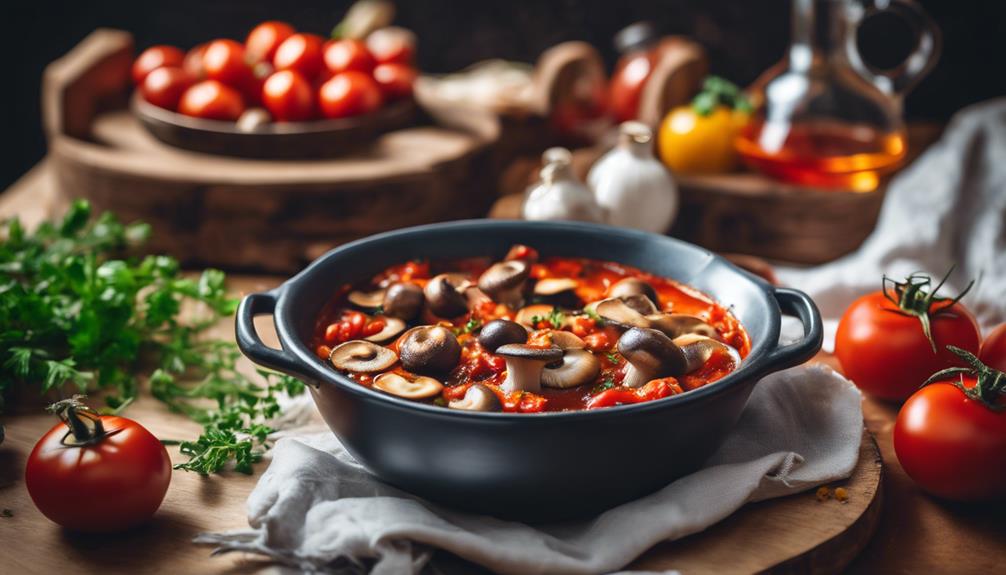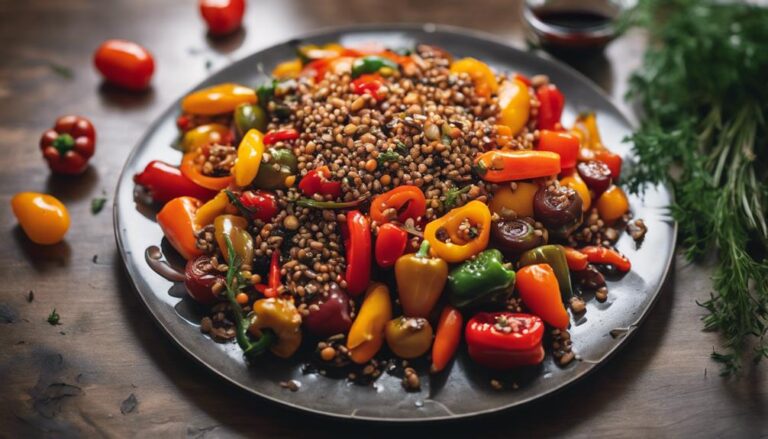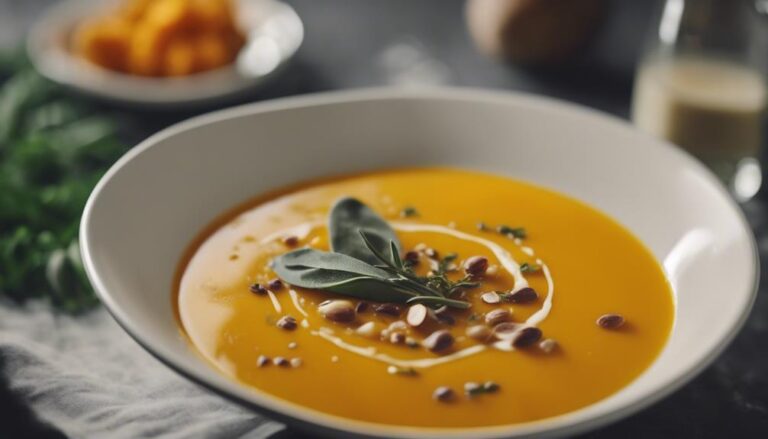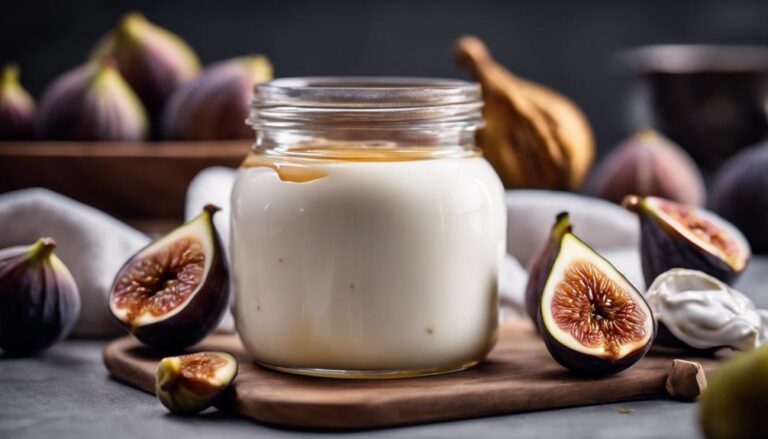Sous Vide Mushroom and Tomato Shakshuka
Discover the perfect fusion of sous vide precision and Mediterranean flavors in Sous Vide Mushroom and Tomato Shakshuka. This dish combines earthy mushrooms, tangy tomatoes, and aromatic spices for a delightful meal. By employing sous vide techniques, you guarantee precise egg cooking temperatures and consistent results. The slow cooking process allows flavors to meld beautifully, resulting in a rich and satisfying dish. Elevate your culinary skills with this unique twist on a classic favorite, promising a delectable experience that will surely impress your taste buds. Uncover the secrets to mastering this flavorful dish and take your cooking to new heights.
What You Will Learn Here
- Sous vide method ensures precise cooking of mushrooms and tomatoes.
- Infuse flavors thoroughly in a controlled temperature environment.
- Maintain the integrity of ingredients for a rich and deep taste.
- Enhance texture and taste with tender mushrooms and tomatoes.
- Elevate Shakshuka by incorporating sous vide technique for a unique twist.
Shakshuka's Origin Story
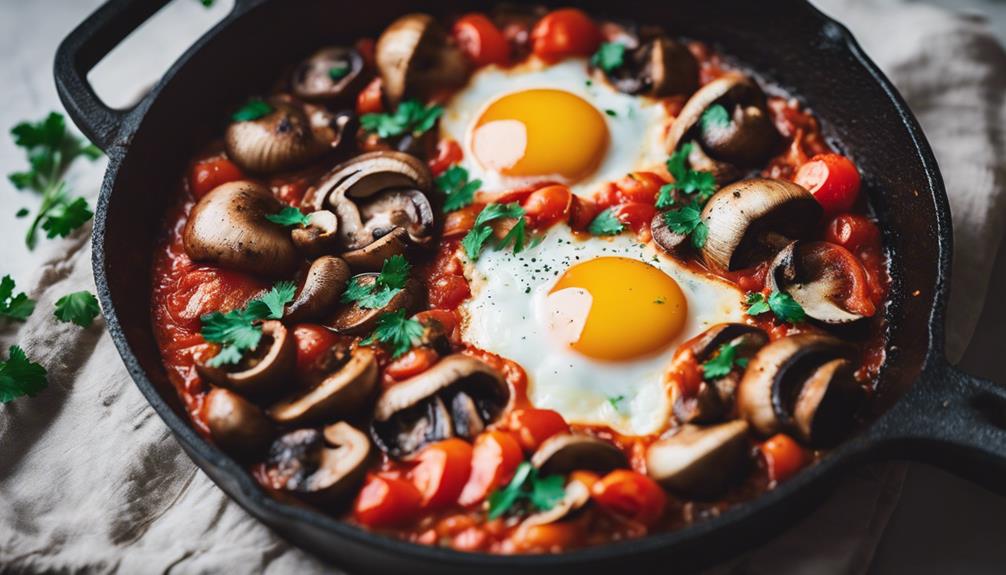
Shakshuka has a rich history, significant cultural ties, and a fascinating evolution. Its historical roots trace back to North Africa, where it originated as a hearty and flavorful dish.
Understanding the cultural significance and evolution of shakshuka provides insights into its enduring popularity and diversity in modern culinary landscapes.
Shakshuka's Historical Roots
Originally believed to have been created in North Africa, this beloved dish made its way into Middle Eastern and Mediterranean cuisines, becoming a staple in many households. Shakshuka's historical roots reveal a blend of culinary influences from the Middle East and traditional ingredients from North Africa. The dish's origin can be traced back to regions like Tunisia, where it was initially created.
Shakshuka's journey across borders allowed it to evolve and adapt to the different palates it encountered. With the Middle East's use of spices and the North African influence of tomatoes and peppers, the dish transformed into the hearty and flavorful meal known today.
Over time, Shakshuka became a popular breakfast option, admired for its simplicity and versatility. The combination of poached eggs in a rich tomato and pepper sauce has captured the taste buds of people worldwide. Its heritage reflects a melting pot of cultures, showcasing how culinary traditions can transcend borders and bring people together through the shared love of food.
Cultural Significance of Shakshuka
Shakshuka's journey from its North African roots to becoming a beloved dish in Middle Eastern and Mediterranean cuisines highlights its cultural significance and widespread appeal. This flavorful dish, traditionally consisting of poached eggs in a simmering tomato and pepper sauce, carries with it a rich history steeped in cultural traditions and global influences.
Originating in North Africa, shakshuka quickly spread across the Mediterranean and Middle East regions, where it became a staple in many households. The dish's ability to adapt to local ingredients and preferences while retaining its essence showcases the interconnectedness of culinary practices around the world. Shakshuka embodies the idea of sharing and communal dining, reflecting the importance of togetherness in various cultures.
Over time, shakshuka has evolved to include diverse variations, incorporating ingredients like feta cheese, spinach, or mushrooms, demonstrating how global influences have shaped its modern interpretations. This evolution highlights the dish's ability to embrace new flavors while still honoring its traditional roots, making it a symbol of culinary fusion and cross-cultural appreciation.
Evolution of Shakshuka
With its roots in North Africa, this popular dish's evolution reflects the dynamic nature of culinary traditions across regions. Shakshuka, a dish traditionally consisting of poached eggs in a spicy tomato and pepper sauce, has undergone various transformations over the years. Originating in countries like Tunisia and Libya, shakshuka's journey has seen it spread to the Middle East, Europe, and beyond.
Modern twists on shakshuka have emerged in recent years, with chefs and home cooks experimenting with new ingredients and techniques. Culinary innovations such as adding mushrooms, feta cheese, or different spices have brought fresh flavors to this classic dish. While the traditional recipe remains cherished, these creative adaptations showcase the adaptability of shakshuka to different palates and culinary trends.
The evolution of shakshuka exemplifies how a dish can transcend borders and time, evolving to suit changing tastes and preferences while retaining its essence. As culinary traditions continue to intermingle, shakshuka stands as a testament to the enduring appeal of dishes that have traversed continents and cultures.
Key Shakshuka Components
To create a flavorful Shakshuka dish, understanding the key components is vital. When it comes to Shakshuka, certain elements play an essential role in shaping the dish's overall taste and presentation. Here are five key components to keep in mind:
- Flavor Profiles: The harmonious blend of spices like cumin, paprika, and chili flakes creates the distinctive rich and savory taste of Shakshuka.
- Ingredients: Fresh tomatoes, bell peppers, onions, and eggs are staple ingredients that form the heart of this dish, contributing to its robust flavors.
- Cooking Techniques: The gentle simmering of the tomato base until it thickens and the eggs are poached to perfection are fundamental techniques in Shakshuka preparation.
- Presentation Styles: Shakshuka can be served in the skillet it was cooked in, garnished with fresh herbs like parsley or cilantro, and accompanied by crusty bread for dipping.
- Balance of Flavors: Achieving the right balance between acidity from tomatoes, sweetness from onions, and heat from spices is essential to a successful Shakshuka dish.
Understanding and mastering these components will elevate your Shakshuka cooking skills to new heights.
Tasty Shakshuka Variations
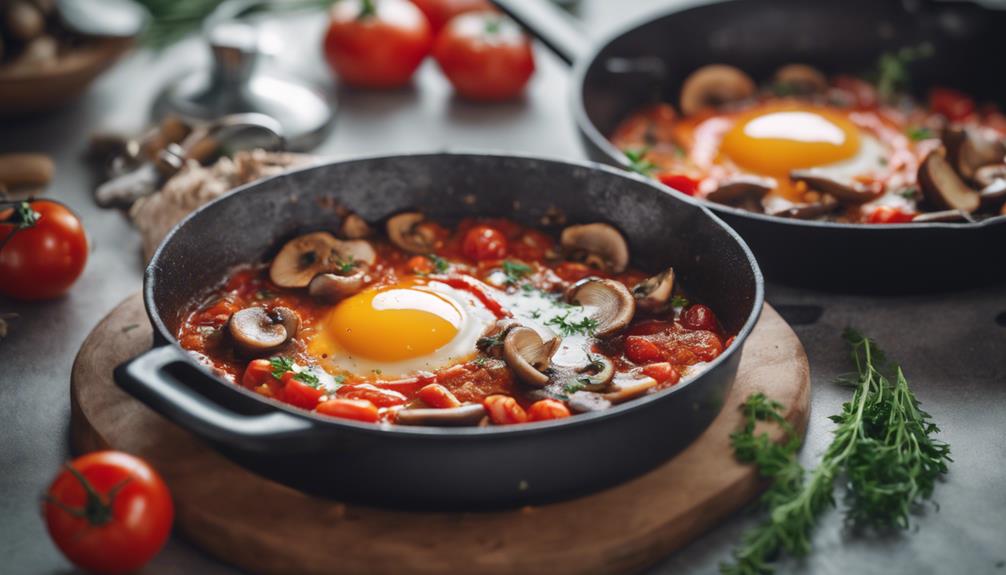
When it comes to tasty Shakshuka variations, there are three exciting options to explore.
You can try a mushroom-filled Shakshuka variant for a unique twist on the classic dish.
For those who enjoy a kick of heat, the spicy Chorizo Shakshuka might be the perfect choice.
Mushroom-filled Shakshuka Variant
Consider incorporating flavorful mushrooms into your traditional Shakshuka for a delightful twist on the classic dish. Mushrooms bring a rich umami flavor that pairs exceptionally well with the tangy tomato base of Shakshuka.
Here are some ideas to elevate your Mushroom-filled Shakshuka Variant:
- Variety is Key: Experiment with different types of mushrooms such as cremini, shiitake, or oyster mushrooms to add depth to your dish.
- Herbaceous Touch: Enhance the earthy flavors by adding fresh herbs like thyme or rosemary to complement the mushrooms.
- Cheese Please: Sprinkle some crumbled feta or grated Parmesan on top for a creamy and salty contrast.
- Egg Options: Try poaching the eggs directly on the mushroom and tomato mixture for a one-pan wonder or bake them in the oven for a different texture.
- Spice it Up: Add a pinch of smoked paprika or cayenne pepper for a subtle kick that balances the savory notes of the mushrooms.
These tips will help you create a Mushroom-filled Shakshuka that's bursting with delicious flavors and textures.
Spicy Chorizo Shakshuka
Enhance your Shakshuka experience with a fiery twist by incorporating spicy chorizo sausage into the classic dish. This addition brings a bold and zesty flavor that complements the rich tomato base of the Shakshuka. Here are some tips to make the most out of your Spicy Chorizo Shakshuka:
- Spicy chorizo variations: Experiment with different types of spicy chorizo to find the one that suits your taste buds best. Whether it's smoked, extra spicy, or mild, the choice of chorizo can greatly impact the overall flavor of your dish.
- Cooking techniques: Consider cooking the chorizo separately before adding it to the Shakshuka to enhance its flavors and make sure it's perfectly cooked.
- Flavorful ingredient pairings: Pair the spicy chorizo with ingredients like bell peppers, onions, and garlic to create a harmonious blend of flavors in your Shakshuka.
- Presentation tips: Garnish your Spicy Chorizo Shakshuka with fresh herbs like cilantro or parsley for a pop of color and added freshness.
- Serve with crusty bread or pita: The bread can help soak up the flavorful tomato sauce and chorizo oils, making each bite even more delicious.
Mediterranean-Inspired Shakshuka With Feta
Indulge in the vibrant flavors of the Mediterranean with a savory Shakshuka featuring tangy feta cheese. This Mediterranean-inspired twist on the classic Shakshuka brings a burst of tanginess to every bite.
Here are some tips to enhance your Shakshuka experience:
- Cheese Pairing: The salty and tangy flavor of feta cheese complements the rich tomato base of Shakshuka perfectly, adding a creamy texture and a delightful contrast to the dish.
- Ingredient Substitutions: Feel free to experiment with different types of cheese if feta isn't your favorite. Try goat cheese for a tangy variation or mozzarella for a milder taste.
- Fresh Herbs: Add a sprinkle of fresh oregano or parsley on top of your Shakshuka for a pop of freshness and added aroma.
- Spice Level: Adjust the spice level to your liking by adding more or less chili flakes or a dash of hot sauce.
- Bread Pairing: Serve your Shakshuka with crusty bread or pita for a complete Mediterranean meal experience.
Shakshuka Egg-Cooking Techniques
When it comes to mastering the art of Shakshuka, paying attention to egg cooking temperatures is essential for achieving the perfect dish.
Timing plays a key role in ensuring your eggs are cooked just right, so be mindful of the clock.
To nail that ideal yolk consistency, remember to follow these simple tips throughout your Shakshuka cooking journey.
Egg Cooking Temperatures
Exploring ideal egg cooking temperatures is important for mastering the art of preparing a perfect Shakshuka dish. When it comes to Shakshuka egg-cooking techniques, sous vide techniques offer precision cooking that aligns with culinary innovation and modern kitchen trends. The sous vide method involves sealing the eggs in airtight bags and cooking them in a water bath at precise temperatures, ensuring consistent results every time.
For a traditional Shakshuka, where the eggs are cracked directly into the simmering tomato and vegetable stew, achieving the perfect egg consistency is vital. The ideal temperature for cooking eggs in a Shakshuka ranges between 145-165°F (63-74°C) when using sous vide techniques. At these temperatures, the egg whites set beautifully while the yolks remain runny, creating a luscious texture that complements the rich flavors of the dish.
Mastering egg cooking temperatures through sous vide methods can elevate your Shakshuka, offering a delightful culinary experience that combines the best of precision cooking with the warmth of a home-cooked meal.
Timing for Perfect Eggs
To achieve perfect eggs in your Shakshuka dish, timing is essential for ensuring that the egg whites set beautifully while the yolks remain runny. Egg doneness is vital in Shakshuka, where the eggs are poached in a flavorful tomato and vegetable stew. There are a few key cooking techniques to take into account to get the eggs just right.
When cooking your Shakshuka, make sure to crack the eggs directly into wells made in the simmering sauce. Cover the pan to trap the steam and help the eggs cook evenly. The ideal timing for perfect eggs with a runny yolk is around 5-7 minutes. This timing allows the egg whites to set while keeping the yolks delightfully creamy and liquid.
Experiment with different cooking techniques to find the perfect egg doneness that suits your taste preferences. Remember, mastering the timing for perfect eggs in your Shakshuka will elevate this comforting dish to a whole new level of deliciousness.
Yolk Consistency Tips
For guaranteeing ideal yolk consistency in your Shakshuka, closely monitor the simmering sauce to make sure the eggs poach to your desired level of runniness. Using sous vide techniques can help you achieve precise control over your egg yolks. By cooking the eggs at a consistent temperature in a water bath, you secure a perfect runny yolk every time.
To maintain the desired yolk consistency, consider these cooking tips. To begin with, make sure to crack the eggs gently into the simmering sauce to avoid breaking the yolks. Next, keep an eye on the eggs as they cook, adjusting the heat as needed to prevent overcooking. Finally, if you prefer a more set yolk, cover the pan with a lid to trap steam and cook the eggs more thoroughly.
Final Thoughts
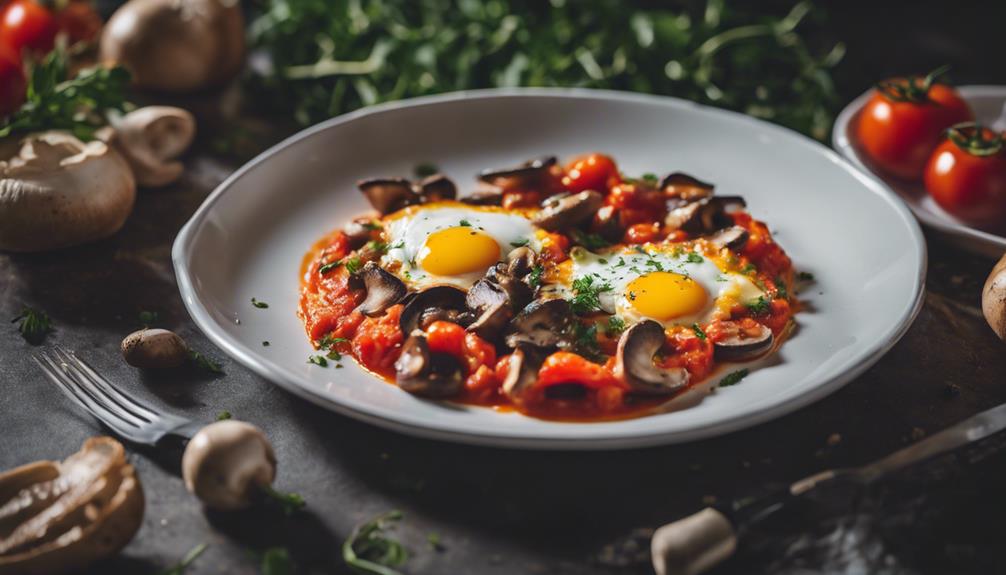
In conclusion, reflecting on the Sous Vide Mushroom and Tomato Shakshuka recipe can enhance your culinary skills and creativity. Considering the reflections on this dish can provide you with valuable insights into flavor combinations, cooking techniques, and presentation styles. This recipe serves as a source of culinary inspiration, encouraging you to experiment with different ingredients and methods in your own kitchen.
Frequently Asked Questions
Can I Use Other Types of Mushrooms Besides Button Mushrooms?
Yes, you can use various mushroom varieties like cremini, shiitake, or portobello for more depth of flavor in your dish. Each type offers a unique taste profile that can enhance the overall experience.
Is It Necessary to Peel the Tomatoes Before Using Them?
When making shakshuka, peeling tomatoes is a personal choice. Some prefer the smooth texture without skins, while others like the added texture. As for mushrooms, feel free to experiment with different varieties for unique flavors.
Can I Add Cheese to My Sous Vide Mushroom and Tomato Shakshuka?
Yes, you can add cheese to your dish. Various cheese options like feta, goat cheese, or parmesan can enhance flavor. Sprinkle it on top before serving for a melty finish. Consider the cooking techniques and how they complement the flavors.
How Long Can I Store Leftover Shakshuka in the Fridge?
To guarantee food safety, store your leftovers properly in the fridge. When meal planning, remember that leftovers are good for a few days. Follow guidelines for storage times to prevent spoilage and enjoy your meals longer.
Can I Use a Different Cooking Method Instead of Sous Vide for This Dish?
Yes, you can use alternative methods for this dish. Experiment with different cooking techniques for varied flavors. Try ingredient substitutions to customize. Broiling, sautéing, or baking are great options. Have fun exploring new ways to prepare your dish!
Conclusion
Overall, sous vide mushroom and tomato shakshuka is a delicious and versatile dish that can be enjoyed for breakfast, lunch, or dinner. By understanding the origins of shakshuka, the key components, tasty variations, and egg-cooking techniques, you can create a flavorful and satisfying meal.
Whether you prefer a traditional recipe or want to experiment with different ingredients, shakshuka offers a unique culinary experience that's sure to impress your taste buds.
